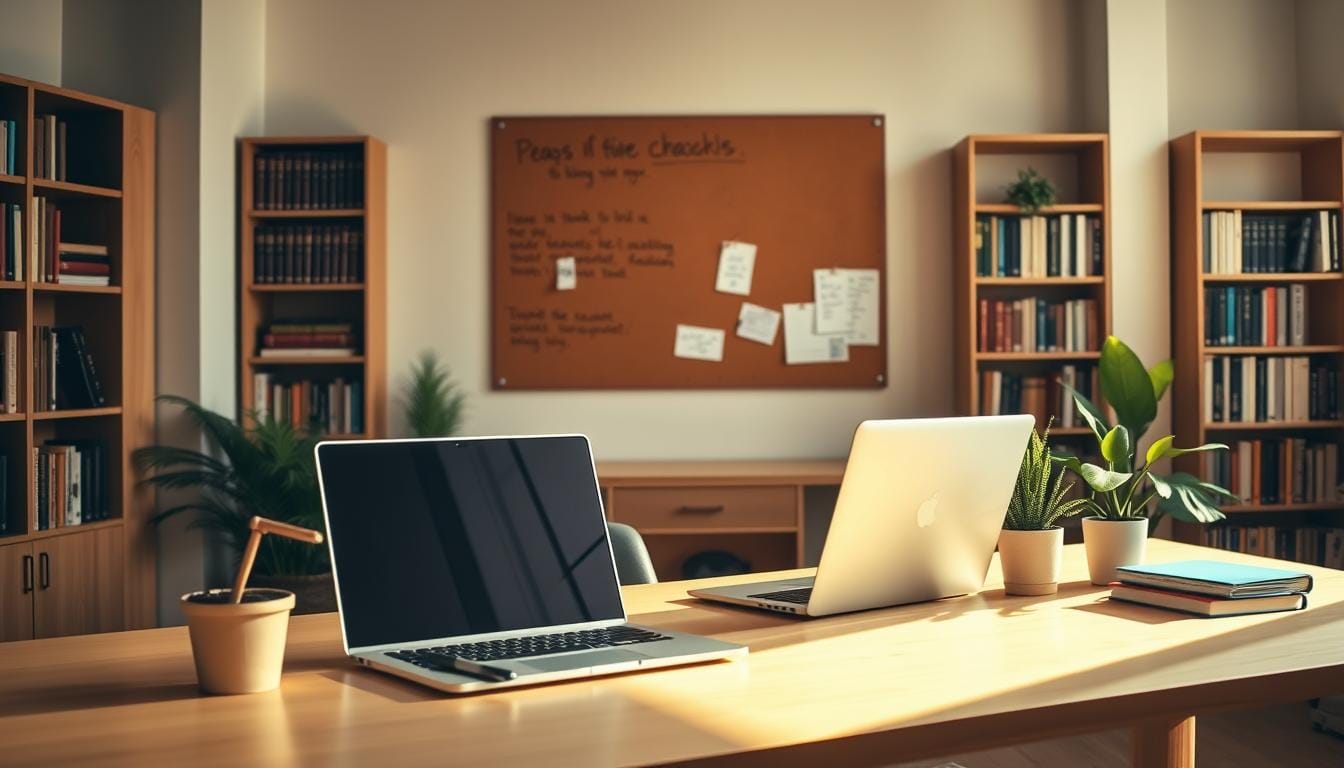10 Productivity Hacks to Transform Your Daily Routine
Table of Contents
Productivity Hacks
Ever feel swamped by your endless to-do list? You’re not alone. Today’s world asks us to balance work and personal life, making staying productive key. Adults make about 35,000 decisions every day, which can exhaust us and slow us down.
Getting better at time management isn’t just about working more. It’s about working smarter. Using the right productivity hacks can change how you tackle your day, helping you do more with less stress.
This guide will show you ten powerful ways to change how you work and live. Each method is made to help you reach your full potential, organize your tasks better, and live a more balanced life.
1. Set Clear Goals for Your Day
first Productivity Hacks is setting clear goals is key to being productive at work. It’s about planning your day well. Break down big dreams into small steps that lead to real progress.
Mastering Small Habit Strategies
Small habits can change how productive you are. Here are some tips:
- Start with two-minute daily habits to get moving
- Use the “1% habit rule” for steady growth
- Focus on small wins to stay motivated
Implementing SMART Goal Techniques
The SMART method is great for setting goals. It makes your goals clear, measurable, and achievable. This boosts your work efficiency a lot.
Your goals should be clear roadmaps, not distant dreams.
Using SMART goals can make team meetings better by 20% in just a quarter. It turns vague ideas into real plans.
Daily Goal-Setting Strategies
- Spend two minutes reviewing your daily goals
- Track your progress with visuals
- Give yourself rewards for tiny habits
Goal setting is about making progress, not being perfect. Focus on small steps. This builds momentum for big wins.
2. Prioritize Tasks Effectively
Managing your workload can feel like navigating a complex maze. It’s crucial to have good prioritization strategies to boost work efficiency and reduce stress. Sadly, most professionals struggle with task management, with 70% feeling overwhelmed by their task lists.

The key to successful productivity is knowing how to tell urgent from important tasks. The Eisenhower Matrix is a powerful tool for making these distinctions. It categorizes tasks into four quadrants based on urgency and importance:
- Urgent and Important: Tasks requiring immediate attention
- Important but Not Urgent: Strategic activities for long-term goals
- Urgent but Not Important: Distractions to minimize
- Neither Urgent nor Important: Tasks to eliminate
Using this approach can improve your decision-making speed by up to 30%. It helps you focus on high-impact activities while reducing time on less critical tasks.
“Prioritization is not about getting everything done, but about getting the right things done.” – Unknown
Other prioritization techniques can also boost your work efficiency. The ABCDE method, for example, helps categorize tasks by importance. This can help you complete 20% more high-priority tasks in a week.
Remember, effective prioritization is a skill that gets better with practice. Start using these strategies gradually. You’ll soon see a big improvement in your productivity and work management.
3. Embrace Time Blocking Techniques
Time blocking is a great way to boost your productivity and manage your day better. It lets you set aside specific times for different tasks. This helps you stay focused and efficient.
By avoiding switching between tasks, you can reduce decision fatigue. This can make you up to 30% more productive.
- Find out what tasks are most important for the day
- Give each task a specific time slot
- Make sure to have blocks for deep work
- Take short breaks to keep your energy up
Allocate Specific Times for Tasks
Good time management means planning ahead. By setting time limits, you avoid tasks taking too long. People who use time blocking see a 50% drop in procrastination.
Try the Pomodoro Technique. It involves working in 25-minute focused sessions.
Stick to Your Schedule for Better Results
Being consistent is crucial with time blocking. Use productivity tools to help you stay on track. Day theming is a more advanced method where you dedicate whole days to certain tasks
Studies show that scheduling breaks can improve your well-being and productivity by 20%.
“Time blocking is not about perfection, but about creating a structured approach to your day.” – Productivity Expert
The aim of time management tips is to work smarter, not harder. By using these tools, you’ll become more focused and efficient.
4. Limit Distractions and Stay Focused
To stay efficient at work, you need to focus on what’s important. Distractions can really hurt your productivity. They can make you waste up to 2 hours a day. It’s key to know what’s holding you back and get rid of it to reach your goals.

First, figure out what’s distracting you the most. Studies show that getting back to work after a break takes about 23 minutes. Also, about 70% of workers feel overwhelmed by distractions at work.
Identify Your Distractions
- Email notifications
- Social media alerts
- Unnecessary meetings
- Chatty colleagues
- Personal phone calls
Create a Distraction-Free Workspace
Having a dedicated space to work is crucial. Here are some tips:
- Choose a specific area for work
- Wear noise-canceling headphones
- Use tools to block distracting websites
- Set clear boundaries for communication
The Pomodoro Technique can boost your focus. It involves working in 25-minute blocks with short breaks9. By using these strategies, you could see your work efficiency go up by 50%10.
Remember, productivity isn’t about working harder, but working smarter by minimizing distractions.
5. Utilize Productivity Tools and Apps

In today’s world, productivity tools are key to getting more done. They help make your work flow better and improve your performance at work and home.
Explore Popular Task Management Apps
Finding the right tools can change how you handle tasks and work with others. Here are some top apps to check out:
- Slack: Makes team talk easier across different areas
- Microsoft Teams: Uses AI to help you work better
- Toggl Track: Gives you detailed reports on how you spend your time
- RescueTime: Shows you how you spend your work hours
Automate Repetitive Tasks for Efficiency
Automation tools can really boost your productivity. Tools like Zapier and IFTTT link different apps to make your work easier. For example, Zapier helps with managing leads and marketing, while IFTTT connects over 900 services.
Using these tools can save you time and let you focus on important tasks. The right tools help you work smarter, not harder.
6. Take Breaks to Boost Your Energy
Work-life balance is not just about working hard. It’s about working smart. Taking strategic breaks can change how you work and stop burnout. After a few hours, your productivity drops, making breaks key for staying energized.

Knowing when and how to take breaks can boost your work efficiency. Here are some strategies to try:
- Practice the Pomodoro Technique: Work in focused 25-minute intervals followed by short breaks
- Follow the 52:17 rule: Work intensely for 52 minutes, then rest for 17 minutes
- Take micro-breaks lasting 5-10 minutes to recharge
Recognizing Your Body’s Signals
Your body tells you when it needs rest. Signs of mental fatigue include less focus, more mistakes, and feeling overwhelmed. By noticing these signs, you can manage your energy better.
“The key is not to prioritize what’s on your schedule, but to schedule your priorities.” – Stephen Covey
Power naps can really help with alertness and mood. Companies like Google use napping pods for employee well-being. Just 10-20 minutes of rest can refresh your mind and boost productivity.
Strategic Break Implementation
Breaks are not a luxury; they’re essential for top performance. Add short breaks to your day to avoid burnout and keep your energy up. With these tips, you’ll find a better way to work.
7. Practice Mindfulness and Meditation
Mindfulness and meditation are great ways to improve your work-life balance. They can change how you think and make you more productive.
Incorporate Short Mindfulness Exercises
Quick mindfulness tricks can really help your mind stay clear. Here are some easy tips:
- Try the 4-7-8 breathing method to calm down
- Take short mindfulness breaks of 1-2 minutes
- Reflect on things you’re thankful for to feel better
Studies show that short mindfulness sessions can really cut down stress. People who do these exercises say they focus better. In fact, 79% of people say their thinking gets sharper.
Use Guided Meditation Apps
Apps can make starting a meditation habit easier. They guide you in building a regular mindfulness practice. Just 10 minutes a day can:
- Lower your anxiety
- Make you feel emotionally better
- Make you happier at work
“Mindfulness is not about being perfect, but about keeping at it and being kind to yourself.”
Turning off your phone for 30 minutes can make you 40% more focused. Starting your path to better productivity is as simple as taking small steps toward mindfulness.
8. Streamline Your Morning Routine
Changing your morning routine can really boost your productivity. The first hours of your day set the stage for success. With about 25,000 mornings in a lifetime, making the most of this time is key.
Getting your morning right needs a plan. Here are some important tips:
- Make your to-do list the night before to avoid morning decisions
- Use two alarms three minutes apart to wake up better
- Drink a full glass of water right after waking
- Stay away from screens to focus better
Prepare the Night Before
Starting your day right begins with getting ready the night before. Choose your outfit, pack your bag, and check tomorrow’s tasks. This saves time and cuts down stress.
Establish Consistent Wake-Up Times
Being consistent is crucial for productivity. Wake up at the same time every day, including weekends. This helps your body adjust and boosts your energy. About 35% of adults don’t get enough sleep, so a regular schedule can really help.
Your morning routine is a powerful tool for personal transformation and productivity.
9. Learn to Say No
Learning to say no is key for good time management and a healthy work-life balance. Many people struggle with taking on too much, which can cause stress and lower productivity. High achievers know how to protect their time and energy by choosing their commitments wisely
Here are some tips for setting boundaries:
- Evaluate each request against your core priorities
- Practice polite and firm declination techniques
- Understand that saying no protects your personal and professional goals
The Pareto Principle shows that 80% of your results come from 20% of your efforts. By saying no, you can focus on the most important tasks. Successful professionals keep a strategic balance between accepting opportunities and protecting their time.
Saying no is not about being difficult, it’s about being strategic with your most valuable resource: time, and it’s the most important step in this journey with the Productivity Hacks.
To decline gracefully, try these tips:
- Pause before automatically saying yes
- Offer alternative solutions when possible
- Be clear and concise in your responses
Remember, setting boundaries is key for work-life balance and avoiding burnout. Your mental health and productivity depend on making smart choices about your time.
10. Reflect and Adjust Regularly
Keeping up with productivity is a journey of self-improvement. Regular reflection helps you see your work patterns and find areas to grow. Time audits can show hidden inefficiencies in your daily life.
By tracking your activities, you’ll learn how you really spend your time. This is different from how you think you spend it.
Setting goals is key to staying productive. SMART goals help you track your progress. Reflecting on your habits regularly can lead to big improvements.
Your strategies for beating procrastination will get better with regular review and adjustment.
Digital tools can make reflecting and improving easier. Many apps help you track your performance and find ways to get better. Studies show reviewing your work can make you up to 15% more efficient.
Remember, being productive is about learning and adapting, not being perfect.
Make reflection a daily habit. Spend a few minutes each evening looking back at what you’ve done, what’s been tough, and how you can do better. This will keep you focused, motivated, and always moving forward in your productivity journey.
Conclusion: Mastering Productivity Through Strategic Habits
As we’ve journeyed through the 10 Productivity Hacks to Transform Your Daily Routine , it’s clear that productivity is not a one-size-fits-all solution but rather a personalized blend of strategies tailored to your unique lifestyle and goals. Each hack presented serves as a stepping stone toward creating a more efficient, focused, and balanced life.
Starting with setting clear goals for your day , we explored how mastering small habit strategies and implementing SMART goal techniques can lay the foundation for success. By prioritizing tasks effectively (Hack #2) and embracing time-blocking techniques (Hack #3), you gain control over your schedule, ensuring that every minute counts toward what truly matters. Allocating specific times for tasks and sticking to your schedule allows you to work smarter, not harder.
Limiting distractions (Hack #4) plays an equally vital role in maintaining focus. Identifying your personal triggers and designing a distraction-free workspace empowers you to stay on track even amidst modern-day interruptions. Leveraging productivity tools and apps (Hack #5) further enhances efficiency by automating repetitive tasks and streamlining workflows.
Taking breaks to boost energy (Hack #6) reminds us that rest is not the enemy of productivity—it’s its ally. Recognizing your body’s signals and strategically incorporating breaks into your routine ensures sustained performance throughout the day. Similarly, practicing mindfulness and meditation (Hack #7) cultivates mental clarity and emotional resilience, equipping you to handle stress with grace.
Streamlining your morning routine (Hack #8) sets the tone for a productive day ahead. Preparing the night before and establishing consistent wake-up times create momentum from the moment you rise. Learning to say no (Hack #9) reinforces boundaries, allowing you to allocate time and energy to high-priority activities.
Finally, reflecting and adjusting regularly (Hack #10) ties everything together. Continuous improvement is at the heart of true productivity. Regular self-assessment helps you identify what works, refine your approach, and adapt to changing circumstances.
Incorporating these productivity hacks into your daily life transforms mundane routines into powerful opportunities for growth. Remember, transformation doesn’t happen overnight, it’s the result of consistent effort and intentional choices. Begin with one hack today, then gradually integrate others until they become second nature.
Your journey toward peak productivity starts now. Which hack resonates most with you? Share your experiences, challenges, and victories as you implement these strategies. Together, let’s redefine what it means to live productively and purposefully.
FAQ
How can I effectively set goals using the SMART criteria?
The SMART criteria help you set clear goals. They ensure your goals are Specific, Measurable, Achievable, Relevant, and Time-bound. For example, instead of saying “I want to be more productive,” a SMART goal is “I will complete three major work projects by the end of the month by dedicating two focused hours each day to my most important tasks.”
What is the Eisenhower Matrix, and how can it help me prioritize tasks?
The Eisenhower Matrix sorts tasks into four groups. These are urgent and important, important but not urgent, urgent but not important, and neither urgent nor important. This method helps you focus on what’s most important and avoid wasting time on less important tasks.
How does time blocking actually improve productivity?
Time blocking schedules specific times for tasks. This creates a structured day and reduces multitasking. By focusing on one task at a time, you avoid distractions and make a clear plan for your day.
What are some effective ways to minimize distractions?
To avoid distractions, create a dedicated workspace. Use website blockers and turn off notifications. Wear noise-canceling headphones and set clear boundaries with others. Mindfulness can also help you stay focused.
What productivity tools do you recommend for managing tasks?
Good tools include Trello for projects, Todoist for tasks, and RescueTime for time tracking. Slack is great for team chats, and Asana organizes workflows. Choose tools that fit your work style.
How does the Pomodoro Technique work?
The Pomodoro Technique uses 25-minute work sessions followed by 5-minute breaks. After four sessions, take a 15-30 minute break. It boosts focus, prevents burnout, and breaks down big tasks.
How can mindfulness help improve my productivity?
Mindfulness reduces stress and boosts focus. Short meditations and deep breathing exercises can clear your mind. They help you tackle tasks with better concentration and emotional balance.
What makes a morning routine effective?
A good morning routine includes preparing the night before and getting enough sleep. Wake up at the same time, stay hydrated, exercise, and practice mindfulness. Avoid screens right away. It sets a positive tone for the day.
Why is learning to say no important for productivity?
Saying no saves your time and energy for important tasks. It prevents overcommitting, reduces stress, and keeps you focused on what’s truly important for your growth.
How often should I reflect on my productivity?
Reflecting regularly is key. Do a daily 10-minute review, a weekly deep dive, and a monthly full review. This helps you improve and adjust your productivity strategies.
Internal Links Added:
External Links Added:
YOUR OPINION VALUES US
LATEST REVIEWS
Sincerely, this is exactly what I was looking for. I have found the right methodology and steps for success, as it combines well with both my job and my personal project. Thank you very much!
Response from
Thanks kindly for your interest and react
Creative thinking plays a major role in shaping one’s personality and integrating it into society, in addition to building confidence.
All the best!
Response from
Thanks kindly for your interest and react
Totaly different idea
I agree, it’s the right path to a we’ll balanced life.
Well done
Response from
Thanks kindly for your interest and react
THANK YOU
Response from
Thanks kindly for your interest and react
Productivity Hacks
Productivity Hacks
Productivity Hacks
Productivity Hacks
Productivity Hacks
Productivity Hacks
Productivity Hacks
Productivity Hacks
Productivity Hacks
Productivity Hacks
Productivity Hacks
Productivity Hacks
Productivity Hacks
Productivity Hacks
Productivity Hacks
Productivity Hacks
Productivity Hacks
Productivity Hacks
Productivity Hacks
Productivity Hacks







Your writing style is so engaging and makes even the most mundane topics interesting to read Keep up the fantastic work
Hello
Thank you so much for your encouragement and support.
It really means a lot to me.
Yours sincerely
Give a round of applause in the comments to show your appreciation!
Just words are enough for me and they touch me deeply. Thank you so much
but a few rounds of applause will warm my heart too much. hhhhhhhhh
It’s your turn now
Thank you for your sharing. I am worried that I lack creative ideas. It is your article that makes me full of hope. Thank you. But, I have a question, can you help me?
Thank you, your article surprised me, there is such an excellent point of view. Thank you for sharing, I learned a lot.